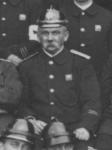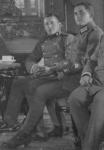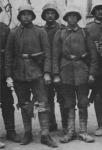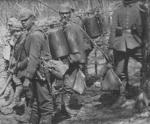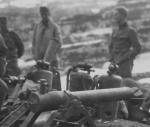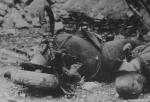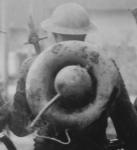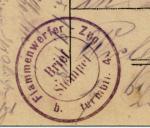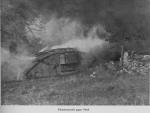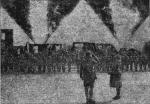
Thomas W
For Deletion-
Posts
788 -
Joined
-
Last visited
-
Days Won
3
Content Type
Profiles
Forums
Blogs
Gallery
Events
Store
Everything posted by Thomas W
-
Ha! Actually it was the profession of many flamethrower pioneers. They were firefighters before they joined the flamethrower regiment, and then they returned to their profession after the war. Here's a photo of the Leipzig municipal fire brigade, taken in 1935. Several of the men are wearing the silver Totenkopf pin that indicates their service in the flamethrower regiment during the war.
-
By the way, I just learned the identity of the first officer whose photo I posted. His name was Karl Walter, and he was the Brandinspektor (Fire Inspector) of Bremerhaven from 1908 to 1919. Interestingly enough, the Bremerhaven Fire Department Web site shows him in his Guard Pioneer uniform, complete with Totenkopf sleeve badge. He's in the second row down from the top, on the left. http://www.feuerwehr...de/leiterbf.htm
-
Very unusual photo I was lucky enough to find on eBay. Men of the 9th Company of the Garde-Reserve-Pionier-Regiment after an attack. Note the torn clothing and bandage, as well as the swollen face of the man in the background. No date, but the writing on the back says: "A squad of flamethrowers following a successful operation (with infantry). Brought to our positions and then picked up the following day. Squad Leader (a Vizefeldwebel) and two men missing."
-
Interesting that you would say that. I have a postcard of a flamethrower squad, sent by a German soldier from an unidentified unit. He writes: "Dear parents and sister! I send you a card with a dangerous killing machine. It is a flamethrower. There is loud smoke and fire that come out from the front. If there is a spark you are lost beyond rescue. Everything else is fine. Goodbye. Best wishes from your son Karl." Imagine being a parent of a soldier and getting that in your mail, especially if you had no idea what a flamethrower was...
-
In 1932 the former commander of the Garde-Reserve-Pionier-Regiment, Bernhard Reddemann, described a flamethrower attack as follows: "A few flamethrower pioneers fall as well. The circular apparatus, which the individuals carry on their backs, is perforated by bullets. The black flame oil runs from it onto the pavement beside the red blood." No explosion. And, just for fun, here's a photo of Austrian troops at the Battle of Ortigara, June 25, 1917. The weapon behind the trench mortar is the kleine 22l M. 15 Flammenwerfer. Note the gaping hole in the oil tank near the bottom. It could be that the flamethrower was hit when empty, but it could also be that the weapon was struck by a high-caliber projectile or shrapnel ball while it was full.
-
This has been a heated topic of debate on lots of forums: Did German flamethrowers explode when hit by bullets or shrapnel? During the flamethrower attack at Hooge on July 30, 1915, at least two different British writers said that a German flamethrower operator exploded into a fireball when his weapon was struck and punctured. However, the death book of the Garde-Reserve-Pionier-Regiment lists no names for Hooge. Order T.17, signed by General Fritz von Below in the autumn of 1916, states unequivocally that flamethrowers do not explode when hit by projectiles. Oberleutnant Charles Theune, commander of the 10th Company of the Garde-Reserve-Pionier-Regiment, wrote that if a flamethrower were punctured by bullets or shrapnel a cushion of air inside the oil chamber would allow the contents to flow out harmlessly from the holes. Propellant pressure for portable flamethrowers was 328 psi (23 atmospheres), which brought the oil pressure to 265 psi (18 atmospheres). The oil was a mixture of coal-tar residue, light and heavy hydrocarbons, coal-tar oil, and carbon disulphide, with a specific gravity of 1. Here's a photo of a Wex M.1917 captured by the Americans at Menil-la-Tour, France, on March 6, 1918. The weapon was in operation when the Americans threw hand grenades at the four flamethrower squads. Note the large tear in lower right-hand quadrant of the ring-shaped oil tank. The American after-action report stated only that the German flamethrower squads dropped all four of the weapons, all of which were riddled with bullets and covered with blood. No flamethrower exploded.
-
Sturmbataillon 4
Thomas W replied to Naxos's topic in Germany: Imperial: Uniforms, Headwear, Insignia & Personal Equipment
-
Sturmbataillon 4
Thomas W replied to Naxos's topic in Germany: Imperial: Uniforms, Headwear, Insignia & Personal Equipment
Here's the back of the card, which is from Pionier Richard Kranz, Flammenwerferzug, Sturmbataillon Nr. 4. The message is as follows: August 1, 1918: "Dear Wilhelm: Am sending cheerful Sunday-greetings from here. Have arrived back well from holidays. It was again a nice time in the lovely homeland. Hopefully you received my package. Dear greetings from your friend Richard. Pioneer Richard Kranz, Flamethrower Platoon, Assault Battalion No. 4, Military Post Office 249." -
Sturmbataillon 4
Thomas W replied to Naxos's topic in Germany: Imperial: Uniforms, Headwear, Insignia & Personal Equipment
-
Thought I should post this: The death book of the German flamethrower regiment, downloadable for $3.00: http://www.lulu.com/content/e-book/totenbu...werfer)/2519204 It's a great reference, with speeches given at the ceremony dedicating the memorial for the regiment, photos, and the names of all 890 flamethrower pioneers who died in the war, their ranks, and the date and place of their deaths.
-
From my own collection: Wex squads training in antitank warfare. Note the mock Renault FT-17 on the right, made of wood. The really bizarre thing about this image is that the person fifth from the right is a young boy wearing knee pants and a soft cap! What's he doing on this training field? Who is he? At the end of the war line pioneers were trained in the use of the Wex for antitank measures. These may be such men.
-
According to Charles Theune, Sturmtruppen und Flammenwerfer (Berlin: Landes-Verlag, 1921), page 187, tanks were to be attacked only from the front, where the hatches, pistol ports, and vision slits could not be closed tightly enough to keep out the burning oil. The War Diary of Sturmpanzerkraftwagen-Abteilung 1 (Bundesarchiv-Milit?rarchiv N 89/5) says that on February 12, 1918, Reddemann and a few other German officers volunteered to sit inside a captured British Mark IV that was sprayed with a flamethrower. Reddemann wanted to see for himself how effective the weapon was. As soon as the flame jet hit the tank, all the oxygen inside was used up and the tank's oil supply caught fire. Reddemann and the others had to immediately bail out. They almost didn't make it, apparently. The famous flamethrower-and-tank image from the Imperial War Museum shows a frontal attack, too. I can't post it here, but I'm sure we've all seen it. In Robin's gruesome photo the only visible flame damage on the side of the tank seems to eminate from the hatches, from inside the vehicle, and it's clear that the unfortunate crew tried desperately to escape. Whatever happened to the tank happened very quickly. The man inside died while crawling, like some of the residents of Pompei. Reddemann defended the use of the flamethrower in his memoirs, saying that some "weak sisters and old maids" in the German homeland objected to the weapon as "inhuman," when in reality (he claimed) it was more humane than other weapons because it caused such "moral shock" in the enemy that he often surrendered without a fight, making further bloodshed unnecessary.
-
Poor-quality illustration from Karl Kraus, Weltgericht Volume II (Vienna: Swoboda & Co., 1919), page 67: Flamethrower troops of the 5th Army greet the Crown Prince by shooting jets of flame into the air to form a "W." There appear to be several large trucks in the background, with flamethrower lances leaned up against them. Too bad the quality of the illustration isn't better. The text says this took place in February of 1918, which was when the men of Sturmbataillon Nr. 5 (Rohr) were unofficially awarded the "W" sleeve badge. I wonder if this was the ceremony to commemorate it? If so, it doesn't seem likely that Reddemann's men were shooting the flames; on the other hand, those are an awful lot of flamethrower lances in the background. Rohr's battalion had a maximum of only eight small flamethrowers and no large, as far as I know. Strange!

